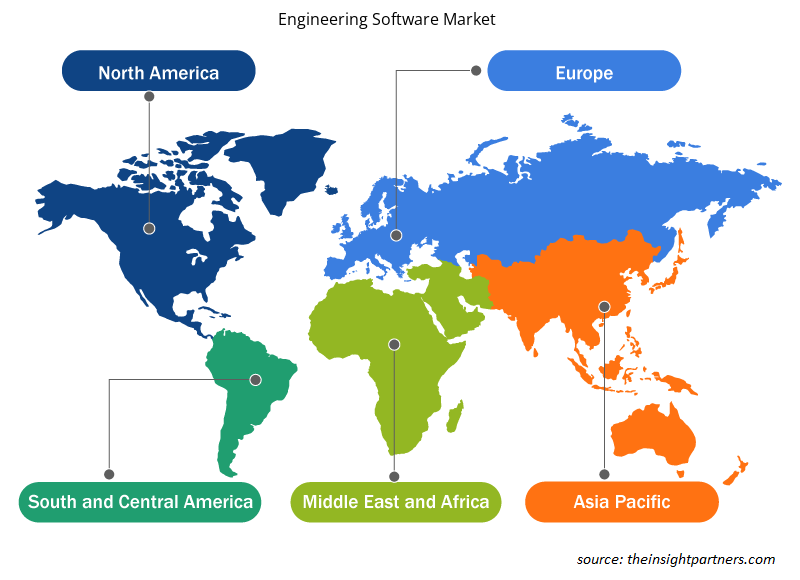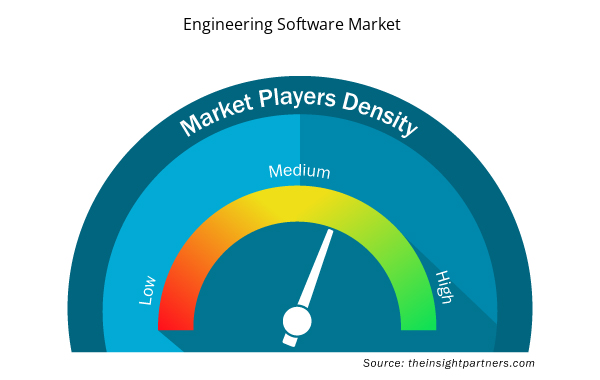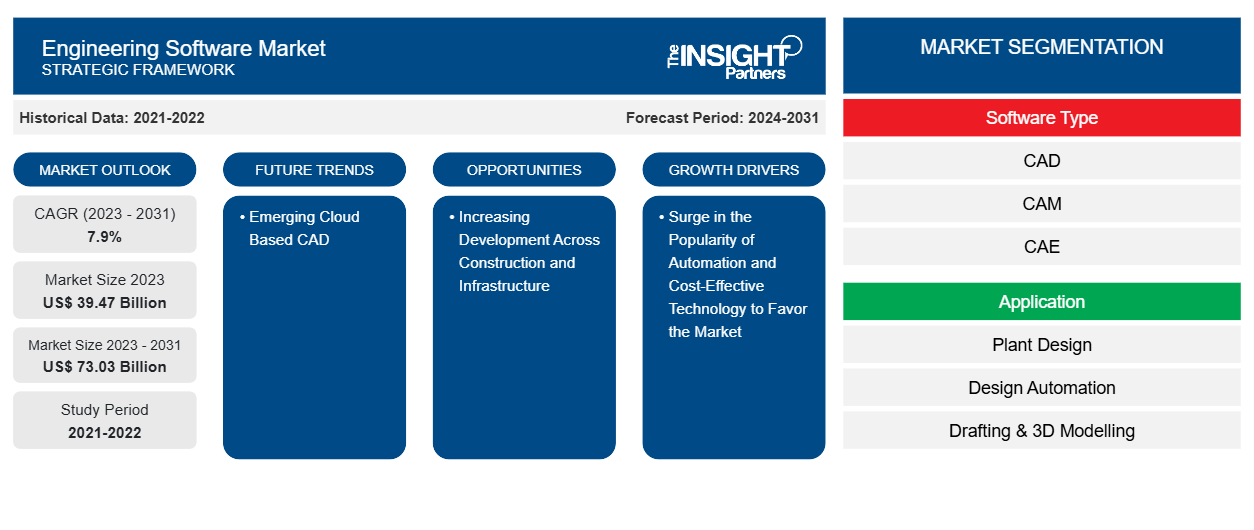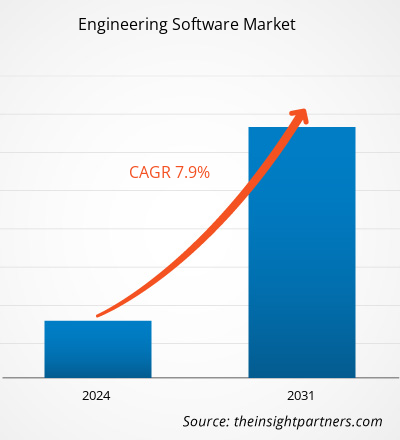Se proyecta que el tamaño del mercado de software de ingeniería alcance los 73.030 millones de dólares en 2031, frente a los 39.470 millones de dólares en 2023. Se espera que el mercado registre una CAGR del 7,9 % entre 2023 y 2031. Es probable que el aumento de la popularidad de la automatización y la tecnología rentable sigan siendo tendencias clave del mercado de software de ingeniería.CAGR of 7.9% in 2023—2031. The surge in popularity of automation and cost-effective technology is likely to remain key engineering software market trends.
Análisis del mercado de software de ingeniería
El creciente uso de software CAD y CAE en una amplia gama de industrias, incluidos los sectores automotriz, aeroespacial, de la construcción y de la atención médica, es responsable de la expansión del mercado. El software para ingeniería comprende, entre otras cosas, el diseño asistido por computadora (CAD), la fabricación asistida por computadora (CAM) y la ingeniería asistida por computadora (CAE). Se prevé que el mercado de software de ingeniería se expanda significativamente durante el período de pronóstico por una variedad de razones, incluida la creciente demanda de las empresas para acortar el tiempo y los gastos del desarrollo de productos.CAE software across a range of industries, including the automotive, aerospace, construction, and healthcare sectors, is responsible for the market expansion. Software for engineering comprises, among other things, computer-aided design (CAD), computer-aided manufacturing (CAM), and computer-aided engineering (CAE). The engineering software market is anticipated to expand significantly throughout the forecast period for a variety of reasons, including mounting demand on businesses to shorten the time and expense of product development.
Descripción general del mercado de software de ingeniería
Los ingenieros, diseñadores y fabricantes pueden redactar documentación de ingeniería crítica, analizar y simular el rendimiento y las operaciones de los productos y desarrollar modelos complejos con la ayuda de soluciones de software de ingeniería. Con las soluciones basadas en la nube, los miembros del equipo pueden colaborar de forma remota utilizando cualquier dispositivo que elijan, ya que se puede acceder a ellas a través de un navegador web. Como resultado, las empresas pueden modernizar y reducir los gastos de hardware sin sacrificar la potencia computacional ni la utilidad.
Personalice este informe según sus necesidades
Obtendrá personalización en cualquier informe, sin cargo, incluidas partes de este informe o análisis a nivel de país, paquete de datos de Excel, así como también grandes ofertas y descuentos para empresas emergentes y universidades.
- Obtenga las principales tendencias clave del mercado de este informe.Esta muestra GRATUITA incluirá análisis de datos, desde tendencias del mercado hasta estimaciones y pronósticos.
Factores impulsores y oportunidades del mercado del software de ingeniería
Aumento de la popularidad de la automatización y la tecnología rentable para favorecer el mercado.
Las plantas 0/0 y las EPC de todo el mundo están bajo presión para reducir los errores de producción y los gastos operativos debido a la intensificación de la rivalidad en el mercado. Los ingenieros de planta pueden mejorar la calidad siguiendo estándares internacionales específicos durante los procesos de diseño, producción y puesta en servicio. Los problemas de producción e intensidad se pueden resolver con software de diseño , análisis continuo y actualizaciones estándar. Como resultado, las empresas de todo el mundo están utilizando cada vez más software de ingeniería para reducir los errores en la construcción y la producción.
Aumento del desarrollo en los sectores de la construcción y la infraestructura
Se cree que uno de los principales factores que contribuyen al desarrollo socioeconómico de cualquier país es la construcción. La industria de la construcción se está expandiendo rápidamente en los países en desarrollo de todo el mundo, incluidos Etiopía, India, China, Brasil, Uzbekistán, Camboya, Tanzania y Myanmar. La infraestructura fundamental de estas economías también se está desarrollando a un ritmo rápido. Por ejemplo, las economías en desarrollo de Asia Pacífico y SAM están atrayendo mucha inversión extranjera directa en el desarrollo de su infraestructura. Estos avances también estimularán el crecimiento de su infraestructura y, a medida que la industria de la construcción se expanda, también lo hará la necesidad de software de ingeniería. Por lo tanto, se anticipa que los avances en expansión en los sectores verticales de negocios de infraestructura y construcción ofrecerán.
Informe de mercado de software de ingeniería Análisis de segmentación
Los segmentos clave que contribuyeron a la derivación del análisis del mercado de software de ingeniería son el tipo de software y la aplicación.
- Según el tipo de software, el mercado de software de ingeniería se divide en CAD, CAM, CAE, AEC y EDA. Se prevé que el segmento CAD crezca en el período de pronóstico.CAE, AEC, and EDA. The CAD segment is anticipated to grow in the forecast period.
- Por aplicación, el mercado se segmenta en diseño de plantas, automatización del diseño , dibujo y modelado 3D, diseño y prueba de productos, entre otros. Se prevé que el segmento de automatización del diseño crezca en el período de pronóstico.
Análisis de la cuota de mercado del software de ingeniería por geografía
El alcance geográfico del informe de mercado de software de ingeniería se divide principalmente en cinco regiones: América del Norte, Asia Pacífico, Europa, Oriente Medio y África, y América del Sur/América del Sur y Central. América del Norte ha dominado el mercado de software de ingeniería. Las tendencias de adopción de alta tecnología en varias industrias en la región de América del Norte han impulsado el crecimiento del mercado de software de ingeniería. Se espera que factores como la mayor adopción de herramientas digitales y el alto gasto tecnológico por parte de las agencias gubernamentales impulsen el crecimiento del mercado de software de ingeniería de América del Norte. Además, un fuerte énfasis en la investigación y el desarrollo en las economías desarrolladas de los EE. UU. Y Canadá está obligando a los actores norteamericanos a traer soluciones tecnológicamente avanzadas al mercado. Además, EE. UU. tiene una gran cantidad de actores del mercado de software de ingeniería que se han centrado cada vez más en el desarrollo de soluciones innovadoras. Todos estos factores contribuyen al crecimiento de la región del mercado de software de ingeniería.
Perspectivas regionales del mercado de software de ingeniería
Los analistas de Insight Partners explicaron en detalle las tendencias y los factores regionales que influyen en el mercado de software de ingeniería durante el período de pronóstico. Esta sección también analiza los segmentos y la geografía del mercado de software de ingeniería en América del Norte, Europa, Asia Pacífico, Oriente Medio y África, y América del Sur y Central.

- Obtenga datos regionales específicos para el mercado de software de ingeniería
Alcance del informe de mercado de software de ingeniería
| Atributo del informe | Detalles |
|---|---|
| Tamaño del mercado en 2023 | US$ 39,47 mil millones |
| Tamaño del mercado en 2031 | US$ 73.03 mil millones |
| CAGR global (2023 - 2031)CAGR (2023 - 2031) | 7,9% |
| Datos históricos | 2021-2022 |
| Período de pronóstico | 2024-2031 |
| Segmentos cubiertos | Por tipo de software
|
| Regiones y países cubiertos | América del norte
|
| Líderes del mercado y perfiles de empresas clave |
|
Densidad de actores del mercado de software de ingeniería: comprensión de su impacto en la dinámica empresarial
El mercado de software de ingeniería está creciendo rápidamente, impulsado por la creciente demanda de los usuarios finales debido a factores como la evolución de las preferencias de los consumidores, los avances tecnológicos y una mayor conciencia de los beneficios del producto. A medida que aumenta la demanda, las empresas amplían sus ofertas, innovan para satisfacer las necesidades de los consumidores y aprovechan las tendencias emergentes, lo que impulsa aún más el crecimiento del mercado.
La densidad de actores del mercado se refiere a la distribución de las empresas o firmas que operan dentro de un mercado o industria en particular. Indica cuántos competidores (actores del mercado) están presentes en un espacio de mercado determinado en relación con su tamaño o valor total de mercado.
Las principales empresas que operan en el mercado de software de ingeniería son:
- PTC
- Automatización Rockwell, Inc.
- SAP SE
- Siemens
- Sinopsis, Inc.
- Autodesk Inc.
Descargo de responsabilidad : Las empresas enumeradas anteriormente no están clasificadas en ningún orden particular.

- Obtenga una descripción general de los principales actores clave del mercado de software de ingeniería
Noticias y desarrollos recientes del mercado de software de ingeniería
El mercado de software de ingeniería se evalúa mediante la recopilación de datos cualitativos y cuantitativos a partir de investigaciones primarias y secundarias, que incluyen publicaciones corporativas importantes, datos de asociaciones y bases de datos. A continuación, se incluye una lista de los avances del mercado:
- En febrero de 2024, la empresa tecnológica global Cognizant se propone acelerar la modernización empresarial ampliando su gama de ofertas de plataformas. La empresa anunció el lanzamiento de Cognizant Flowsource, una plataforma generativa habilitada para IA diseñada para impulsar la nueva era de la ingeniería de software.
(Fuente: Cognizant, nota de prensa, 2024)
- En junio de 2023, se lanzó Nullspace, Inc. como una escisión de IERUS Technologies, un contratista de defensa establecido en Huntsville, Alabama. Nullspace, Inc. se enfoca en brindar software de ingeniería avanzado para aplicaciones electromagnéticas.
(Fuente: Nullspace, nota de prensa, 2023)
Informe sobre el mercado de software de ingeniería: cobertura y resultados
El informe "Tamaño y pronóstico del mercado de software de ingeniería (2021-2031)" proporciona un análisis detallado del mercado que cubre las siguientes áreas:
- Tamaño del mercado y pronóstico a nivel global, regional y nacional para todos los segmentos clave del mercado cubiertos bajo el alcance
- Dinámica del mercado, como impulsores, restricciones y oportunidades clave
- Principales tendencias futuras
- Análisis detallado de las cinco fuerzas de Porter y PEST y FODA
- Análisis del mercado global y regional que cubre las tendencias clave del mercado, los principales actores, las regulaciones y los desarrollos recientes del mercado.
- Análisis del panorama de la industria y de la competencia que abarca la concentración del mercado, el análisis de mapas de calor, los actores destacados y los desarrollos recientes
- Perfiles detallados de empresas
- Análisis histórico (2 años), año base, pronóstico (7 años) con CAGR
- Análisis PEST y FODA
- Tamaño del mercado Valor/volumen: global, regional, nacional
- Industria y panorama competitivo
- Conjunto de datos de Excel



Report Coverage
Revenue forecast, Company Analysis, Industry landscape, Growth factors, and Trends

Segment Covered
This text is related
to segments covered.

Regional Scope
North America, Europe, Asia Pacific, Middle East & Africa, South & Central America

Country Scope
This text is related
to country scope.
Preguntas frecuentes
The global Engineering Software market is expected to reach US$ 73.03 billion by 2031.
The key players holding majority shares in the global Engineering Software market are PTC, Rockwell Automation, Inc., SAP SE, Siemens, Synopsys, Inc., Autodesk Inc., AVEVA, and Dassault Systèmes.
Increasing development across construction and infrastructure is impacting engineering software, which is anticipated to play a significant role in the global engineering software market in the coming years.
The surge in the popularity of automation and cost-effective technology is the major factors that propel the global engineering software market growth.
The global engineering software market was estimated to be US$ 39.47 billion in 2023 and is expected to grow at a CAGR of 7.9% during the forecast period 2024 - 2031.
Trends and growth analysis reports related to Technology, Media and Telecommunications : READ MORE..
The Insight Partners performs research in 4 major stages: Data Collection & Secondary Research, Primary Research, Data Analysis and Data Triangulation & Final Review.
- Data Collection and Secondary Research:
As a market research and consulting firm operating from a decade, we have published and advised several client across the globe. First step for any study will start with an assessment of currently available data and insights from existing reports. Further, historical and current market information is collected from Investor Presentations, Annual Reports, SEC Filings, etc., and other information related to company’s performance and market positioning are gathered from Paid Databases (Factiva, Hoovers, and Reuters) and various other publications available in public domain.
Several associations trade associates, technical forums, institutes, societies and organization are accessed to gain technical as well as market related insights through their publications such as research papers, blogs and press releases related to the studies are referred to get cues about the market. Further, white papers, journals, magazines, and other news articles published in last 3 years are scrutinized and analyzed to understand the current market trends.
- Primary Research:
The primarily interview analysis comprise of data obtained from industry participants interview and answers to survey questions gathered by in-house primary team.
For primary research, interviews are conducted with industry experts/CEOs/Marketing Managers/VPs/Subject Matter Experts from both demand and supply side to get a 360-degree view of the market. The primary team conducts several interviews based on the complexity of the markets to understand the various market trends and dynamics which makes research more credible and precise.
A typical research interview fulfils the following functions:
- Provides first-hand information on the market size, market trends, growth trends, competitive landscape, and outlook
- Validates and strengthens in-house secondary research findings
- Develops the analysis team’s expertise and market understanding
Primary research involves email interactions and telephone interviews for each market, category, segment, and sub-segment across geographies. The participants who typically take part in such a process include, but are not limited to:
- Industry participants: VPs, business development managers, market intelligence managers and national sales managers
- Outside experts: Valuation experts, research analysts and key opinion leaders specializing in the electronics and semiconductor industry.
Below is the breakup of our primary respondents by company, designation, and region:

Once we receive the confirmation from primary research sources or primary respondents, we finalize the base year market estimation and forecast the data as per the macroeconomic and microeconomic factors assessed during data collection.
- Data Analysis:
Once data is validated through both secondary as well as primary respondents, we finalize the market estimations by hypothesis formulation and factor analysis at regional and country level.
- Macro-Economic Factor Analysis:
We analyse macroeconomic indicators such the gross domestic product (GDP), increase in the demand for goods and services across industries, technological advancement, regional economic growth, governmental policies, the influence of COVID-19, PEST analysis, and other aspects. This analysis aids in setting benchmarks for various nations/regions and approximating market splits. Additionally, the general trend of the aforementioned components aid in determining the market's development possibilities.
- Country Level Data:
Various factors that are especially aligned to the country are taken into account to determine the market size for a certain area and country, including the presence of vendors, such as headquarters and offices, the country's GDP, demand patterns, and industry growth. To comprehend the market dynamics for the nation, a number of growth variables, inhibitors, application areas, and current market trends are researched. The aforementioned elements aid in determining the country's overall market's growth potential.
- Company Profile:
The “Table of Contents” is formulated by listing and analyzing more than 25 - 30 companies operating in the market ecosystem across geographies. However, we profile only 10 companies as a standard practice in our syndicate reports. These 10 companies comprise leading, emerging, and regional players. Nonetheless, our analysis is not restricted to the 10 listed companies, we also analyze other companies present in the market to develop a holistic view and understand the prevailing trends. The “Company Profiles” section in the report covers key facts, business description, products & services, financial information, SWOT analysis, and key developments. The financial information presented is extracted from the annual reports and official documents of the publicly listed companies. Upon collecting the information for the sections of respective companies, we verify them via various primary sources and then compile the data in respective company profiles. The company level information helps us in deriving the base number as well as in forecasting the market size.
- Developing Base Number:
Aggregation of sales statistics (2020-2022) and macro-economic factor, and other secondary and primary research insights are utilized to arrive at base number and related market shares for 2022. The data gaps are identified in this step and relevant market data is analyzed, collected from paid primary interviews or databases. On finalizing the base year market size, forecasts are developed on the basis of macro-economic, industry and market growth factors and company level analysis.
- Data Triangulation and Final Review:
The market findings and base year market size calculations are validated from supply as well as demand side. Demand side validations are based on macro-economic factor analysis and benchmarks for respective regions and countries. In case of supply side validations, revenues of major companies are estimated (in case not available) based on industry benchmark, approximate number of employees, product portfolio, and primary interviews revenues are gathered. Further revenue from target product/service segment is assessed to avoid overshooting of market statistics. In case of heavy deviations between supply and demand side values, all thes steps are repeated to achieve synchronization.
We follow an iterative model, wherein we share our research findings with Subject Matter Experts (SME’s) and Key Opinion Leaders (KOLs) until consensus view of the market is not formulated – this model negates any drastic deviation in the opinions of experts. Only validated and universally acceptable research findings are quoted in our reports.
We have important check points that we use to validate our research findings – which we call – data triangulation, where we validate the information, we generate from secondary sources with primary interviews and then we re-validate with our internal data bases and Subject matter experts. This comprehensive model enables us to deliver high quality, reliable data in shortest possible time.


 Obtenga una muestra gratuita de este informe
Obtenga una muestra gratuita de este informe